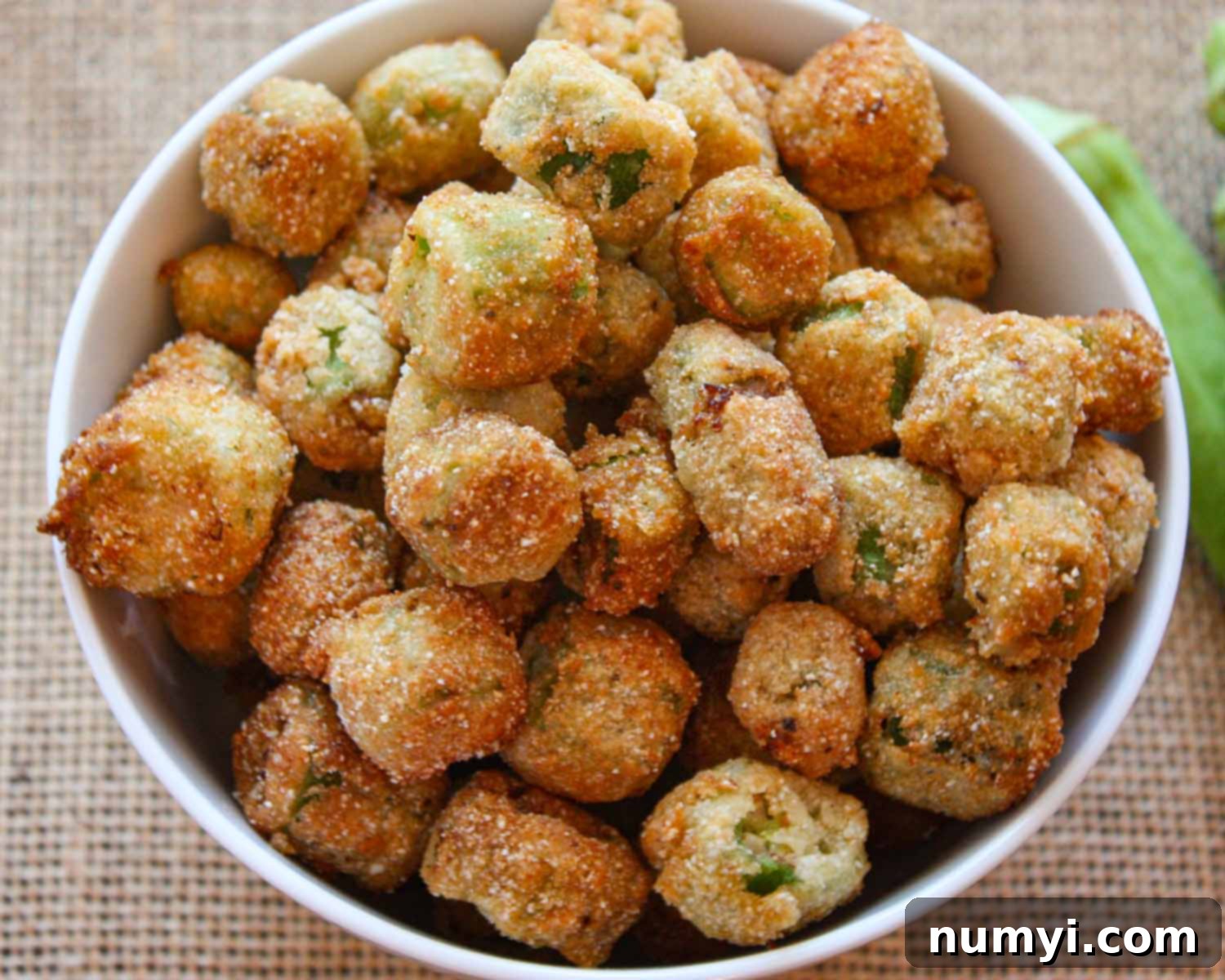Crispy Buttermilk Fried Okra: A Classic Southern Side Dish Recipe
There are few things as quintessentially Southern as a plate piled high with perfectly crispy buttermilk fried okra. This dish isn’t just a side; it’s a celebration of summer, tradition, and simple, delicious ingredients. Imagine tender okra pods coated in a tangy buttermilk bath, then dredged in a seasoned cornmeal mixture, and finally fried to a golden-brown perfection. Each bite delivers an irresistible crunch, followed by a burst of fresh, earthy flavor. If you’ve never experienced the joy of homemade fried okra, prepare to be amazed. This easy-to-follow recipe will quickly become a cherished summer staple in your home, just as it is in ours.
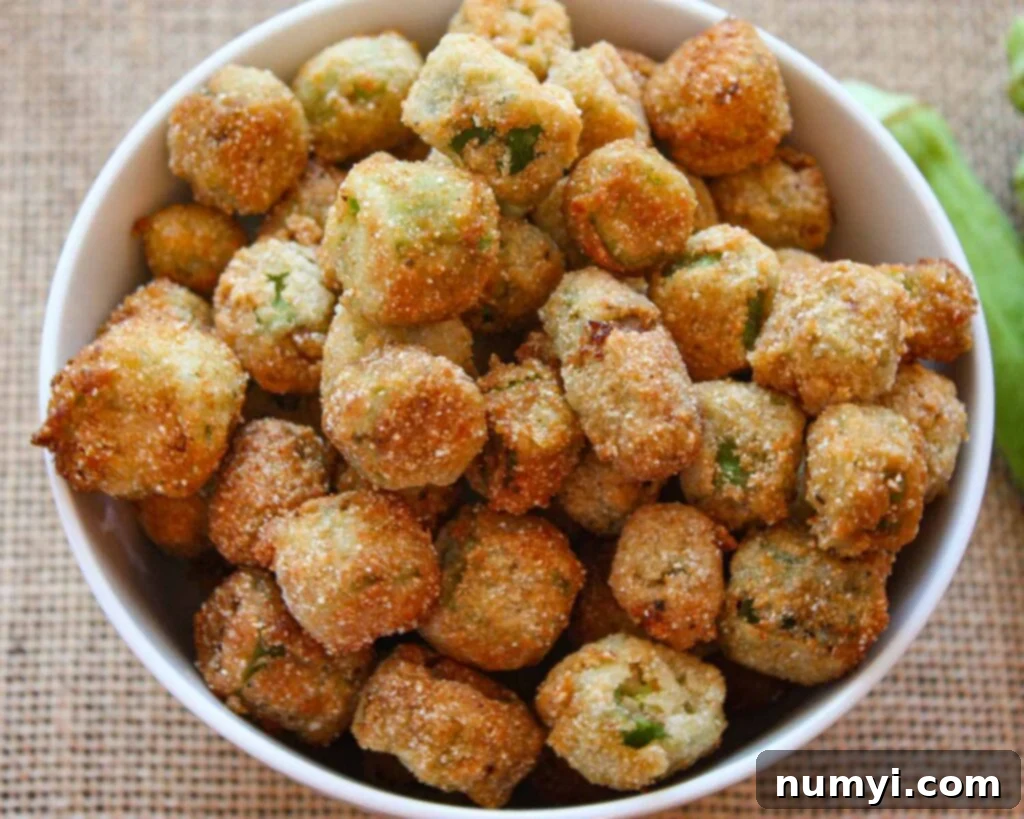
Why You’ll Love This Crispy Fried Okra Recipe
The allure of Southern buttermilk fried okra is undeniable. It’s a dish that evokes memories of family gatherings, warm summer evenings, and the simple pleasures of garden-fresh produce. This particular recipe stands out for several compelling reasons, guaranteeing a culinary experience you’ll want to revisit again and again.
Firstly, the taste is simply unparalleled. When you’re lucky enough to receive a bounty of fresh okra, perhaps from a generous coworker’s garden, frying it is one of the absolute best ways to enjoy its delicate flavor. While pickling okra or roasting okra offer wonderful alternatives, there’s a special magic that happens when it’s fried with a buttermilk and cornmeal coating.
This homemade version vastly surpasses any frozen, pre-battered okra you might find in a supermarket. The difference in freshness, texture, and flavor is remarkable. You control the quality of ingredients and the frying process, resulting in a superior side dish that tastes authentic and comforting. Furthermore, the deep-frying method is excellent for combating okra’s naturally slimy texture, transforming it into something gloriously crispy and enjoyable.
The simplicity of this recipe is another major draw. It requires minimal effort and basic ingredients, making it accessible for even novice cooks. My own mother taught me a simpler pan-fried method using just cornmeal, which I still adore for its straightforward charm. However, this buttermilk-battered version elevates the experience, providing a thicker, more robust crunch that truly makes it the best-fried okra I’ve ever had. It’s an essential part of Southern cuisine, offering a taste of tradition that’s both easy to prepare and incredibly satisfying.
Buttermilk fried okra pairs beautifully with a range of classic Southern dishes. Consider serving it alongside a hearty Succotash Recipe, a slice of fluffy Buttermilk Cornbread, or as a vibrant contrast to savory main courses like Smoked Chicken Wings with Alabama White Sauce, or a comforting platter of Baked Macaroni and Cheese. It’s a versatile side that adds texture and flavor to almost any meal.
Essential Ingredients for Perfect Buttermilk Fried Okra
Crafting this crispy Southern fried okra recipe requires only a handful of readily available ingredients, each playing a crucial role in achieving that perfect golden-brown crunch and irresistible flavor. Here’s what you’ll need and why each component is so important:
- Fresh Okra: This is the star of the show, and its freshness makes all the difference. When selecting okra, look for bright green, blemish-free pods that are firm to the touch and typically around 3 inches long. Smaller pods are generally more tender, while much larger ones tend to be older, tougher, and more fibrous, which can affect the final texture. We strongly recommend against using frozen okra, as it often becomes soft and mushy after cooking, losing the desired crispiness that defines this dish.
- Self-Rising Cornmeal Mix: For that signature crispy and crunchy texture, self-rising cornmeal mix is our top choice. The fine grind of the cornmeal creates a sturdy coating, while the leavening agents in the self-rising mix contribute to a lighter, airier batter. While some recipes call for a combination of all-purpose flour and cornmeal, or even just flour, we find that pure cornmeal mix delivers the most authentic and satisfying Southern fried okra experience. The cornmeal provides a coarser, more distinct crunch that flour alone simply cannot replicate.
- Buttermilk: This tangy dairy product is non-negotiable for true Southern fried okra. Some recipes might suggest an eggwash, but any seasoned Southerner will confirm that buttermilk is the only way to go. Its natural acidity helps to tenderize the okra slightly and provides a subtle tangy flavor that complements the richness of the frying. More importantly, buttermilk creates a thicker, more adherent coating for the cornmeal, ensuring every piece of okra is beautifully battered and incredibly crispy. If you don’t have buttermilk on hand, don’t worry! You can easily make a substitute by adding one tablespoon of lemon juice or white vinegar to 1 cup of regular milk and letting it stand for 5 to 10 minutes until it slightly curdles.
- Salt and Black Pepper: These foundational seasonings are all you truly need to enhance the natural flavors of the okra and the cornmeal. Their simplicity allows the fresh taste of the okra to shine through. However, feel free to experiment with other seasonings if you desire a spicier or more complex flavor profile, such as garlic powder, cayenne pepper, or a classic Cajun or Creole seasoning blend.
- Vegetable Oil for Frying: The choice of frying oil is important for achieving a crisp, non-greasy result. Common vegetable oils like canola oil, peanut oil, or even corn oil work wonderfully. These oils have a high smoke point, which is crucial for deep frying at the correct temperature without burning. Avoid olive oil or butter, as their lower smoke points are unsuitable for this cooking method.
How to Make Perfect Buttermilk Fried Okra
Making delicious, crispy buttermilk fried okra at home is surprisingly simple. Follow these steps for a truly authentic Southern experience:
Step 1: Prepare the Okra
Begin by thoroughly washing your fresh okra pods and patting them dry. Using a sharp knife, trim off the stem ends and slice the okra pods into uniform 1/2-inch thick pieces. Consistency in size ensures even cooking. Place these cut okra pieces into a large bowl.

Step 2: Buttermilk Soak
Pour the buttermilk over the sliced okra in the bowl, ensuring all pieces are evenly coated. Stir gently to distribute the buttermilk. Once coated, place the bowl of buttermilk-soaked okra in the refrigerator for at least 30 minutes. This crucial step allows the buttermilk to slightly tenderize the okra and helps the cornmeal coating adhere better, leading to a crispier finish.
Don’t Sweat The Recipe is supported by its readers. We may earn a commission if you purchase through a link on our site. Learn more.
Step 3: Season and Dredge
While the okra is chilling, prepare your dredging mixture. In a separate large bowl, combine the self-rising cornmeal mix, salt, and black pepper. Whisk these dry ingredients together until well mixed. Once the okra has chilled, remove it from the refrigerator. Using a slotted spoon, transfer the buttermilk-coated okra (in batches if necessary) into the cornmeal mixture. Toss the okra until each piece is thoroughly and evenly coated. For an extra crispy crust, you can gently press the cornmeal onto the okra pieces. This step is as easy as it sounds!
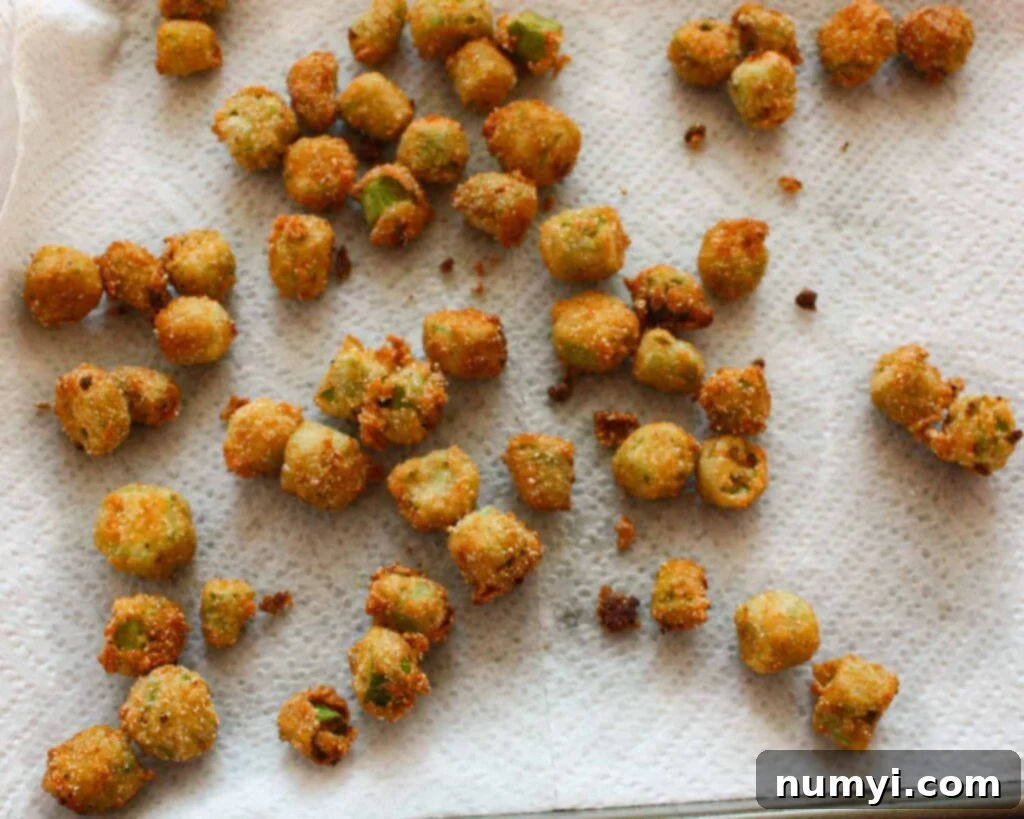
Step 4: Heat the Oil
Pour your chosen vegetable oil into a large, deep cast-iron skillet or Dutch oven. You’ll want the oil to be about 1 inch deep. Heat the oil over medium-high heat until it reaches a temperature of 300°F (150°C). A frying thermometer is highly recommended for accurate temperature control, which is key to perfectly fried okra. If you don’t have a thermometer, you can test the oil by dropping a single piece of coated okra into it; if it immediately starts sizzling and bubbling, the oil is ready. Alternatively, an electric deep fryer can also be used, set to the appropriate temperature.
Step 5: Fry to Perfection
Carefully add the coated okra to the hot oil in small batches. Avoid overcrowding the pan, as this will lower the oil temperature and result in soggy, rather than crispy, okra. Fry the okra for about 4 to 5 minutes, stirring occasionally to ensure even cooking and browning on all sides, until it turns a beautiful golden brown and becomes delightfully crispy. As each batch finishes frying, use a slotted spoon to transfer the okra to a sheet pan lined with paper towels to drain any excess oil. This step helps maintain crispiness.
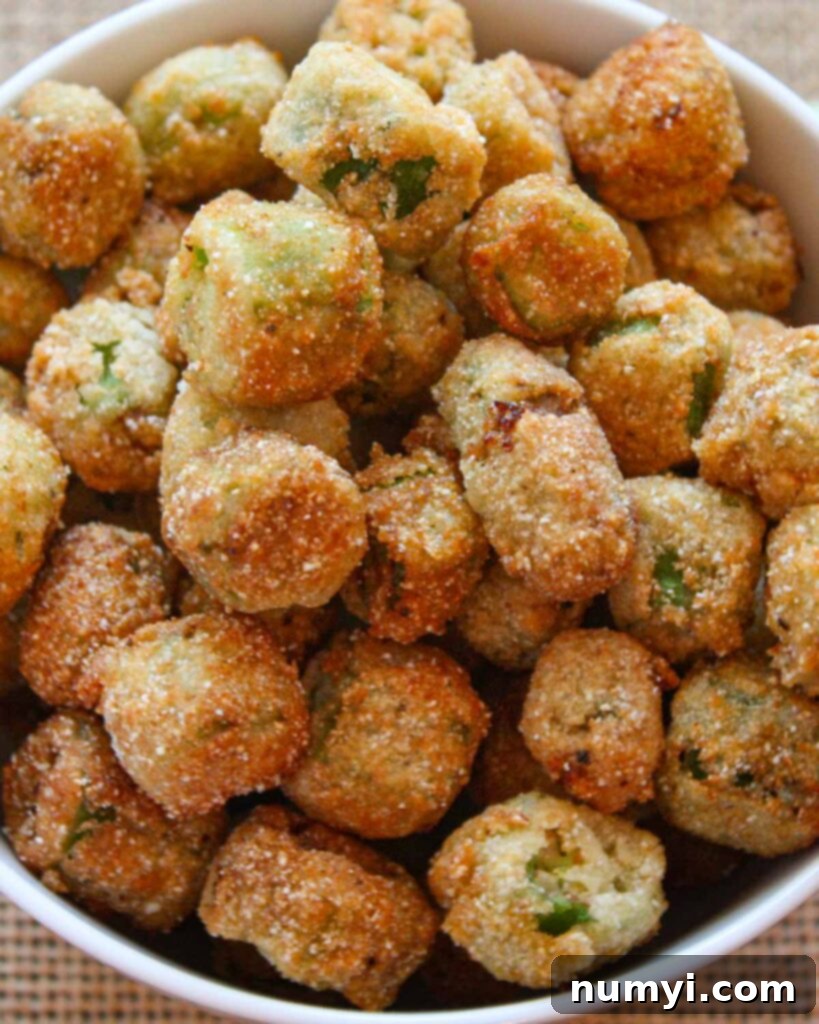
Serve your golden brown fried okra immediately while it’s hot and at its crispiest. Enjoy this beloved Southern classic!
What to Serve with Fried Okra
Perfect crispy fried okra is an incredibly versatile side dish that complements almost any meal, whether it’s a hearty protein or a flavorful meatless option. Its crunchy texture and savory taste make it a fantastic addition to a variety of cuisines, though it shines brightest alongside classic Southern fare.
Consider pairing this delightful side with:
- Chicken: Whether it’s smoked chicken wings, pan-seared chicken breasts, or a classic fried chicken dinner, the okra offers a satisfying textural contrast.
- Pork: Pulled pork sandwiches, grilled pork chops, or even a simple baked ham are all elevated by a side of crispy okra.
- Beef: From juicy steaks to flavorful pot roasts or classic meatloaf, fried okra can add a touch of Southern comfort.
- Fish and Seafood: It’s a natural fit for catfish, shrimp, or any other fried seafood, completing a true Southern fish fry experience.
- Vegetarian Meals: Don’t limit it! Fried okra can be a star component of a larger vegetarian spread, pairing well with rice and beans, collard greens, or a fresh summer salad.
If you enjoy dipping your crispy fried delights, a creamy sauce is a fantastic accompaniment. Homemade ranch dressing, with its cool and tangy profile, is an exceptionally popular and delicious choice that perfectly balances the rich, fried flavors.
Storage, Reheating, and Freezing Fried Okra
While buttermilk fried okra is undoubtedly best enjoyed fresh out of the fryer, it is possible to store, reheat, and even freeze it. However, it’s important to manage expectations, as the ultimate crispiness of freshly fried okra is difficult to fully replicate after storage.
Storage:
If you have any leftover fried okra, allow it to cool completely before transferring it to an airtight container. Store it in the refrigerator for up to 3 days. This prevents moisture buildup, which can make the okra soggy.
Reheating:
To bring some of that crispiness back, avoid the microwave, which will only make it soft. Instead, reheat your fried okra using one of these methods:
- Oven: Preheat your oven to 325°F (160°C). Spread the okra in a single layer on a baking sheet. Heat for about 15 minutes, or until warmed through and somewhat crispy.
- Air Fryer: For an even better result, an air fryer works wonders. Preheat the air fryer to 350°F (175°C). Place the okra in a single layer in the basket (you may need to work in batches). Cook for about 5 minutes, shaking the basket halfway through, until hot and crisp.
Even with these methods, the reheated okra may not be quite as crisp as it was when first fried, but it will still be delicious.
Freezing:
You have the option to freeze okra either before or after frying. For the best quality, we recommend freezing uncooked, breaded okra:
- Freezing Uncooked Okra: This method yields better results for maintaining texture. After coating the okra in buttermilk and cornmeal, arrange the breaded okra in a single layer on a baking sheet. Flash-freeze for about 30 minutes, or until the pieces are firm. This prevents them from sticking together. Once flash-frozen, transfer the okra to a freezer-safe airtight container or a resealable freezer bag. It can be stored for up to 3 months. When ready to cook, fry the okra directly from frozen, following the instructions in the recipe, adding a minute or two to the cooking time if necessary.
- Freezing Cooked Okra: While possible, fried okra tends to become less crispy and can have a softer texture after being frozen and thawed. If you must freeze cooked okra, flash-freeze it on a baking sheet, then transfer to an airtight container. Reheat as described above, preferably in an air fryer or oven.
Tips for the Crispiest Buttermilk Fried Okra
Achieving perfectly crispy, flavorful buttermilk fried okra is a culinary art that’s easy to master with a few key tips:
- Always Have Buttermilk On Hand (or a Substitute!): Buttermilk is truly essential for the authentic taste and texture of this dish. I always keep it in my refrigerator, especially for making my homemade biscuits! If you run out, a quick substitute is simple: add one tablespoon of lemon juice or white vinegar to 1 cup of regular milk, stir, and let it stand for 5 to 10 minutes until it slightly curdles.
- Prioritize Fresh Okra: While freezing okra is an option, for the absolute best results, I highly suggest using fresh okra. Frozen okra tends to release more water upon thawing, which can lead to a mushier texture after frying, compromising the desired crispiness.
- Choose and Prepare Okra Carefully: Select okra pods of similar size for even cooking; around 3 inches long is ideal. Avoid pods that are excessively large or appear old, as these are often tough, fibrous, and less flavorful. Trim the ends and slice uniformly to ensure consistent tenderness.
- Master Oil Temperature: This is perhaps the most critical tip for perfectly fried okra. Use a frying thermometer to precisely control the oil temperature, aiming for 300°F (150°C). If the oil is too hot, the okra will burn on the outside before cooking through, leaving the inside raw. If the oil is too cool, the okra will absorb excess oil, becoming greasy and soggy. If you don’t have a thermometer, drop one small piece of coated okra into the oil; if it immediately starts sizzling and turns golden within a minute, your oil is ready.
- Fry in Batches: Avoid overcrowding the skillet. Frying too much okra at once will drastically lower the oil’s temperature, leading to less crispy results. Work in small batches, giving each piece ample space to fry evenly. This also prevents the okra from sticking together.
- Stir Occasionally While Frying: Gently stir the okra in the oil as it fries. This ensures that all sides of the okra pieces are exposed to the hot oil, promoting uniform browning and crispiness.
- Drain Properly: Once golden brown and crispy, transfer the fried okra to a paper towel-lined sheet pan. This step is vital for absorbing any residual oil, keeping your okra from becoming greasy and helping to maintain its crunch.
- Experiment with Seasonings: While salt and black pepper are classic and delicious, don’t hesitate to customize your fried okra. For a kick, try adding a pinch of garlic powder, onion powder, cayenne pepper, or a favorite Cajun or Creole seasoning blend to your cornmeal mixture.
Frequently Asked Questions About Buttermilk Fried Okra
Absolutely! An air fryer is a great alternative for a less oily version, though the texture will be slightly different from deep-fried. To use an air fryer, preheat it to 400°F (200°C). You will need to work in batches to avoid overcrowding. Place the breaded okra in a single layer in the air fryer basket, then liberally spray the okra with cooking spray or a light mist of oil. Cook for 5 minutes, open the basket and shake the okra vigorously to redistribute, then cook for another 5 to 7 minutes, or until it’s golden brown and crisp to your liking. Keep a close eye on it to prevent burning.
While you can bake okra, it typically will not achieve the same level of crispiness as the fried version, which is why I don’t generally recommend this method for a truly “fried” okra experience. However, if you prefer baking, preheat your oven to 425°F (220°C). Liberally spray a baking sheet with cooking spray or a thin layer of oil. Spread the breaded okra in a single layer on the prepared baking sheet. Bake for about 20 to 25 minutes, making sure to toss the okra around on the pan about halfway through baking to ensure even browning and to encourage crispiness. It will be cooked and flavorful, but expect a softer, less crunchy result compared to deep frying.
The buttermilk soak is key to reducing sliminess! The acidity in the buttermilk helps to break down the mucilage that causes okra’s notorious sliminess. Also, ensuring the oil is hot enough (300°F) and not overcrowding the pan will lead to quick, crisp frying, which minimizes the “slimy” factor. Finally, using fresh, well-dried okra is crucial; excess moisture on the outside can contribute to a gummy texture.
More Southern Side Dish Recipes
Easy Pecan Roasted Sweet Potato Casserole
Southern Yellow Squash Casserole
Broccoli Cheese Casserole with Rice
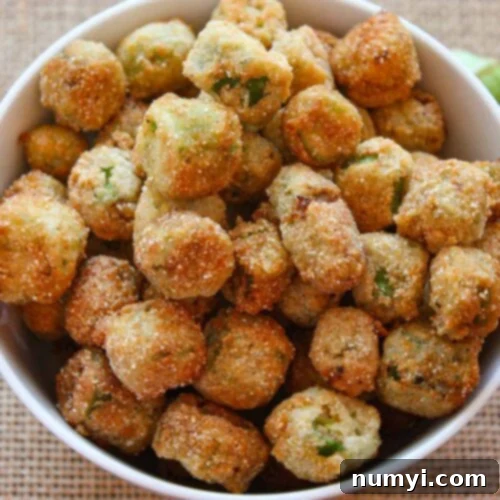
Buttermilk Fried Okra Recipe
Print
Pin
Rate
Ingredients
- 1 pound Fresh okra cut into 1/2-inch-thick slices
- 3/4 cup Buttermilk
- 1 1/2 cups Self-rising white cornmeal mix
- 1 teaspoon Salt
- 1/4 teaspoon Black pepper
- Vegetable oil for frying
Instructions
-
In a large bowl, combine the freshly cut okra and buttermilk, stirring until all the okra pieces are evenly coated. Cover the bowl and refrigerate for 30 minutes to allow the flavors to meld and the buttermilk to slightly tenderize the okra.1 pound Fresh okra, 3/4 cup Buttermilk
-
In a separate large bowl, combine the self-rising cornmeal mix, salt, and black pepper. Whisk these dry ingredients together thoroughly to ensure the seasoning is evenly distributed.1 1/2 cups Self-rising white cornmeal mix, 1 teaspoon Salt, 1/4 teaspoon Black pepper
-
Remove the okra from the buttermilk, in batches, using a slotted spoon. Allow any excess buttermilk to drip off before proceeding to the next step.
-
Transfer the okra to the cornmeal mixture. Dredge the okra thoroughly, tossing it until each piece is completely coated. For extra crispiness, gently press the cornmeal onto the okra. Then, place the coated okra in a wire-mesh strainer and gently shake off any excess breading.
-
Pour vegetable oil into a large, deep cast-iron skillet or Dutch oven, to a depth of 1 inch. Heat the oil over medium-high heat until it reaches 300°F (150°C). Use a deep-fry thermometer for accuracy, or test by dropping a small piece of okra into the oil; it should sizzle immediately.Vegetable oil for frying
-
Carefully add the coated okra to the hot oil in small batches, ensuring not to overcrowd the skillet. Fry for about 4 to 5 minutes, stirring occasionally to promote even cooking, until the okra is golden brown and perfectly crispy. Using a slotted spoon, transfer the fried okra to a paper towel-lined sheet pan to drain any excess oil. Serve immediately for the best texture and flavor.
Notes
Feel free to enhance the flavor of your fried okra by adding other seasonings to the cornmeal mix, such as garlic powder, onion powder, a touch of cayenne pepper for heat, or a pre-made Cajun or Creole seasoning blend.
For detailed instructions on storing, reheating, and freezing your buttermilk fried okra, please refer to the “Storage, Reheating, and Freezing” section within the blog post above.
Nutrition
There’s truly nothing quite like a batch of homemade buttermilk fried okra. Its crispy texture and simple, savory flavor make it a beloved Southern tradition that transcends mere side dish status. Whether you’re serving it at a family barbecue, a weeknight dinner, or a special occasion, this recipe promises to deliver a delightful taste of Southern hospitality. Embrace the crunch, savor the flavor, and enjoy making this timeless classic in your own kitchen!
